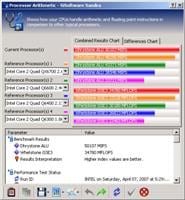Intel Core 2 Extreme QX6800
How we configured our test systems: When configuring our test systems for this article, we first entered their respective system BIOSes and set each board to its "Optimized" or "High Performance Defaults". We then saved the settings, re-entered the BIOS and manually set the memory for DDR2-800 operation with 4,4,4,12 timings. The hard drives were then formatted, and Windows XP Professional (SP2) was installed. When the Windows installation was complete, we installed the drivers necessary for our components, and removed Windows Messenger from the system. Auto-Updating and System Restore were then disabled and we set up a 1024MB permanent page file on the same partition as the Windows installation. Lastly, we set Windows XP's Visual Effects to "best performance," installed all of our benchmarking software, defragged the hard drives, and ran the tests.
|
|
|
|
System 1: Core 2 Extreme QX6800 (2.93GHz - Quad-Core) Core 2 Extreme QX6700 (2.66Hz - Quad-Core) Core 2 Extreme X6800 / E6700 (2.93GHz & 2.66GHz)
Intel D975XBX2
2x1GB Corsair PC-6400 |
System 2:
2x1GB Corsair PC-6400 |
System 3: AMD Athlon 64 FX-74 AMD Athlon 64 FX-72 AMD Athlon 64 FX-70 (3.0GHz, 2.8GHz, 2.6GHz) Asus L1N64-SLI WS (NVIDIA nForce 680a SLI)
4x512MB Corsair PC-6400 WD740 "Raptor" HD 10,000 RPM SATA Windows XP Pro SP2 nForce Drivers v9.53 NVIDIA Forceware v91.27 DirectX 9.0c |
|
|
|
| Preliminary Testing with SiSoft SANDRA XI | |
| Synthetic Benchmarks |
The Core 2 Extreme QX6800 performed just as you'd expect it would in the various SANDRA subsystem tests. In the CPU and Multimedia benchmarks, it was clearly the fastest of the bunch thanks to its higher frequency. The Multi-Core Efficiency benchmark had it finishing behind a high-end Xeon rig, and in the Memory Bandwidth, Memory Latency, and Memory and Cache benchmarks, the QX6800 finished in-line with other similarly configured Intel-based reference systems.












